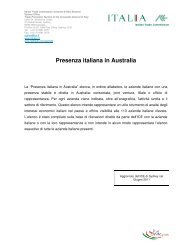Price Determination in the Australian Food Industry A Report
Price Determination in the Australian Food Industry A Report
Price Determination in the Australian Food Industry A Report
You also want an ePaper? Increase the reach of your titles
YUMPU automatically turns print PDFs into web optimized ePapers that Google loves.
Figure 16. Natural cheddar cheese: Major drivers of prices and costs<br />
The cheese category is very diverse, with a wide range of products that create more than 50 cheese styles and more than 500<br />
SKUs (stock keep<strong>in</strong>g units) at retail level. The analysis is performed on <strong>the</strong> major l<strong>in</strong>es of matured (or tasty) cheese.<br />
1. Farm production factors<br />
• Production volumes are relatively<br />
stable year to year.<br />
• National production is strongly<br />
seasonal <strong>in</strong> low-cost production<br />
regions where milk is mostly used <strong>in</strong><br />
manufacture of commodity products.<br />
• Most cheese plants are located <strong>in</strong> or<br />
near low-cost production milk fields.<br />
• While raw milk is highly perishable,<br />
cheese is storable.<br />
2. Value-cha<strong>in</strong> <strong>in</strong>tegration<br />
• Strong <strong>in</strong>tegration of activities along <strong>the</strong><br />
cha<strong>in</strong> with much of cheese production<br />
controlled by cooperatives.<br />
• Increas<strong>in</strong>g commoditis<strong>in</strong>g of bulk cheese<br />
manufacture implies that susta<strong>in</strong>able<br />
cheese production facilities must have<br />
viable by-product markets for processed<br />
whey and o<strong>the</strong>r components.<br />
• Greater concentration of toll cut-and-wrap<br />
operations to <strong>in</strong>crease throughput scale<br />
efficiencies.<br />
3. The market<strong>in</strong>g approach<br />
• Increas<strong>in</strong>g differentiation of cheese products<br />
<strong>in</strong>to market use segments – lunchbox,<br />
enterta<strong>in</strong>ment, low-fat etc.<br />
• Consolidation of <strong>the</strong> ownership of cheese<br />
brands.<br />
• Increas<strong>in</strong>g use of brand and co-brand<br />
partner<strong>in</strong>g strategies.<br />
• Steady growth <strong>in</strong> style and taste niches –<br />
proliferation of farmhouse, varietal and<br />
regional cheese styles <strong>in</strong> <strong>in</strong>dulgence<br />
markets.<br />
Market<strong>in</strong>g<br />
Farm production Manufacture Packag<strong>in</strong>g Distribution Retail<br />
Imports<br />
<strong>Food</strong> service<br />
4. Regulation and compliance<br />
• Increas<strong>in</strong>g costs of compliance<br />
with environmental, welfare<br />
and food safety requirements<br />
for milk producers and<br />
processors.<br />
5. Trade impacts<br />
• Strong <strong>in</strong>fluence of imported<br />
New Zealand cheddar cheese<br />
which has approx. 25% of<br />
domestic market. Hence<br />
prevail<strong>in</strong>g world commodity<br />
prices determ<strong>in</strong>e prices <strong>in</strong><br />
major l<strong>in</strong>es.<br />
• Increas<strong>in</strong>g export volumes of<br />
commodity cheese underp<strong>in</strong>s<br />
expansion <strong>in</strong> <strong>in</strong>dustry<br />
manufacture.<br />
6. Technology and <strong>in</strong>novation<br />
• Significant <strong>in</strong>vestment <strong>in</strong> applied<br />
technology and <strong>in</strong>novation <strong>in</strong> milk<br />
production to achieve better component<br />
attributes.<br />
• Increas<strong>in</strong>g application of size efficiency<br />
<strong>in</strong> milk production and <strong>in</strong> cheese<br />
manufacture.<br />
• Increas<strong>in</strong>g size efficiencies and<br />
automation <strong>in</strong> cut-and-pack operations.<br />
• Greater <strong>in</strong>vestment <strong>in</strong> <strong>in</strong>novation <strong>in</strong><br />
extraction and fur<strong>the</strong>r process<strong>in</strong>g of milk<br />
components (for example, whey powder)<br />
<strong>in</strong>to high-value niche <strong>in</strong>gredients.<br />
7. Retail market dynamics<br />
• The steady growth of <strong>the</strong><br />
private label <strong>in</strong> bulk product<br />
l<strong>in</strong>es.<br />
• Greater demand for<br />
customisation, convenience<br />
and lifestyle solutions <strong>in</strong><br />
cheese applied to meal and<br />
snack usage.<br />
• Greater retail concentration<br />
has resulted <strong>in</strong> strong marg<strong>in</strong><br />
pressure.<br />
Figure 17. Natural cheddar cheese, 500g and 1kg, supply cha<strong>in</strong> map<br />
<strong>Price</strong> <strong>Determ<strong>in</strong>ation</strong> <strong>in</strong> <strong>the</strong> <strong>Australian</strong> <strong>Food</strong> <strong>Industry</strong> A <strong>Report</strong><br />
26<br />
Farmer<br />
Farmer<br />
Approx. 11,000<br />
dairy farmers,<br />
with more than<br />
9,000 shar<strong>in</strong>g<br />
directly <strong>in</strong> <strong>the</strong><br />
cheese market.<br />
receival consolidation<br />
haul<br />
Processor Market Logistics Retail<br />
Manufacturer<br />
Cut and Wrap<br />
• Cheese consumes 38% of all<br />
milk.<br />
• Four major manufacturers<br />
with more than 80% of<br />
process<strong>in</strong>g market.<br />
• Very diverse array of small<br />
and regional cheese makers.<br />
• Yield factor is approx.<br />
9.9 litres of milk per kg of<br />
cheese – this varies with<br />
o<strong>the</strong>r varieties due to<br />
different fat content.<br />
• This function has become<br />
more concentrated with toll<br />
cut-and-wrap facilities at<br />
Bega and Kraft.<br />
Brand Ownership/Management<br />
distribution and logistics<br />
Delivery<br />
Franchise<br />
Wholesaler<br />
• Distribution strategies of<br />
dairy companies vary as<br />
most cheese companies<br />
are not <strong>in</strong>volved <strong>in</strong> <strong>the</strong><br />
fresh dairy products<br />
market.<br />
• 25% of cheese by volume<br />
is imported, mostly from<br />
New Zealand.<br />
Cha<strong>in</strong><br />
Retailer<br />
Independent<br />
and<br />
Convenience<br />
Retailer<br />
<strong>Food</strong> Service<br />
• Cha<strong>in</strong> retail share<br />
<strong>in</strong>creas<strong>in</strong>g to more than<br />
75% of grocery retail sales<br />
volumes.<br />
• Block cheese has about<br />
45% of cheese market.<br />
• Cheddar largest category<br />
of domestic cheese with<br />
55% of cheese market.<br />
Consumer







